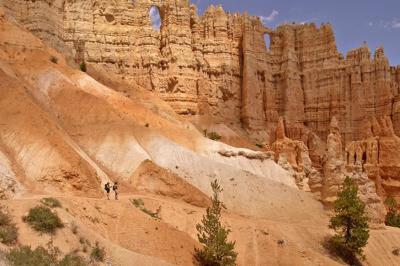Overview
At dawn and dusk, mule deer graze the forested plateau along the road into Bryce Canyon. The alpine environment is home to dozens of species of mammals and birds, all acquainted with a spectacular truth: this is no ordinary forest.
Description
Water and wind over millions of years of freezes and thaws have carved into the plateau endless fields of the park's distinctive red rock pillars, called hoodoos, into the park's series of natural amphitheaters. Seek out the canyon floor on foot or stick to the overlooks by car. Bryce Canyon National Park invites discovery.
Every year, Bryce Canyon National Park awes visitors with spectacular geological formations and brilliant colors. The towering hoodoos, narrow fins, and natural bridges seem to deny all reason or explanation, leaving hikers gazing around with jaws agape in wondrous incredulity. This surreal landscape is what brings people from around the world to visit Bryce Canyon National Park.
How are those Hoodoos and fins formed? It starts with rainwater seeping into cracks in the rock. The water freezes during Bryce’s cold nights, expands and breaks apart the rock. The deep, narrow walls called “fins” result from rain and snowmelt running down the slopes from Bryce’s rim. Eventually the fins form holes (called windows), and when the windows grow larger they collapse and create the bizarre hoodoos that we see today.
Hiking in Bryce Canyon National Park is the best way to immerse yourself in the amazing geography. Day hikes range from easy 1-mile loops to challenging 11-mile round-trip adventures. As you hike, be sure to check out the bristlecone pine trees for which Bryce is known. Bristlecone pines are the oldest trees in the world, even reaching 5,000-years-old in some places!
An overnight stay in one of Bryce Canyon National Park’s campgrounds is highly recommended to experience the early morning and late evening in Bryce, when the pink-orange sandstone goes through a dramatic transformation of light, shadow, and color. A view of Bryce under a full moon is also an experience you will never forget. And when the moon is dark, Bryce is one of the best places in the nation for stargazing because of its pristine air and lack of surrounding development.
And because Bryce Canyon National Park is at an elevation of 8,000 to 9,000 feet, there are even opportunities for winter sports like snowshoeing and cross-country skiing — something you might not have expected in the Utah desert!
Hiking and Backpacking
Getting away from the road and hitting the trails is a great way to take in the superlative scenery Bryce Canyon National Park has to offer. Read more.
Scenic Driving
While the hiking in Bryce Canyon National Park is superb, those who are unable to hike can enjoy the park’s 18-mile scenic drive (Highway 63). If you only have a short amount of time, make sure you stop at Sunrise, Sunset, Inspiration, and Bryce viewpoints! Read more.
Camping
A camping experience in Bryce Canyon National Park is one you won’t forget. Nothing beats seeing the sunrise and set while throwing otherworldly pink and orange light off the hoodoos, or stargazing on a moonless night. Read more.
Stargazing
Bryce Canyon offers world-class stargazing due to its exceptionally high air quality and long distance from sources of light pollution. Learn more.
Winter Sports
Because Bryce Canyon National Park is at an elevation of 8,000 to 9,000 feet, when it snows there are wonderful opportunities for winter sports like snowshoeing and cross country skiing — something you won’t find in many other national parks. See more.
Unnamed Road, Bryce Bryce, Utah 84764
Bryce Canyon National Park, Utah
United States



